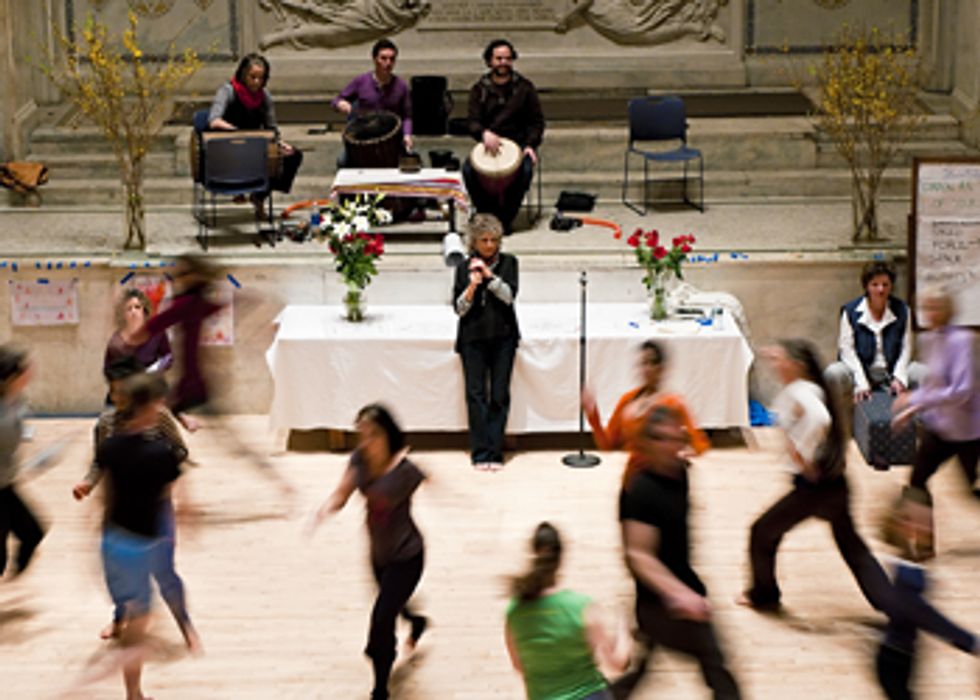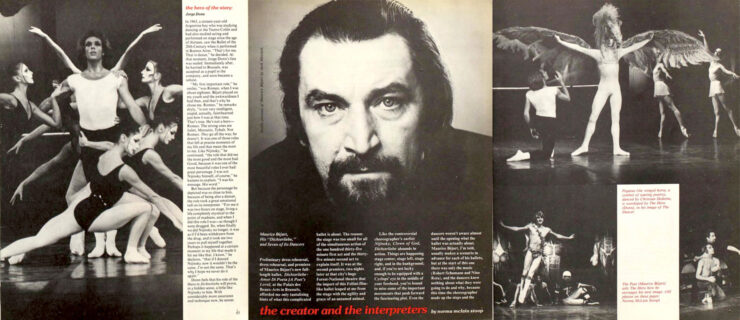Teacher's Wisdom: Anna Halprin
A treasured dance artist in the Bay Area, Anna Halprin came to NYC last spring and gave two workshops at Judson Memorial Church, organized by Movement Research. It was her first time there, completing a historic circle: Some of the dancers who made Judson Dance Theater notorious in the 1960s had been Halprin’s students in Marin County. Yvonne Rainer, Trisha Brown, Simone Forti, Sally Gross, and Meredith Monk had danced on the outdoor deck designed by her late husband, landscape architect Lawrence Halprin.
Now 90, Halprin is still an inspiring figure. Her six-decade career includes making controversial dances (see “They Did What?!” Nov. 2006), working to integrate black and white communities, healing through dance, and developing the Life/Art Process with her daughter Daria, a psychotherapist. Her choreographic work has recently enjoyed a surge of interest in Europe, and Swiss filmmaker Ruedi Gerber’s award-winning film about her,Breath Made Visible, has played in many cities.Dance Magazine‘s Wendy Perron took one of the Judson workshops and interviewed Halprin, a 2004 Dance Magazine Award recipient. The conversation began with Halprin’s declaration, “I love teaching more than anything.”
You’ve often said you were inspired by Margaret H’Doubler at University of Wisconsin, Madison. How did her being a biologist influence you?
She was a great teacher. She wanted you to learn about the power of dance as a form of education. She taught the science of movement. We were required to do human dissection. It was a source of enormous opening for me.
Were you surprised by anything in the dissection?
I was astonished by what muscles look like! They look like fish; they’re covered with this luminous sheath. Inside are millions of tiny silver fibers. Seeing that, you understand how you can use degrees of force, how you can contract or release a little bit.
When did you first dance in New York?
At the ANTA Theater during a modern dance series in 1955. I was the only person from outside of NY, so I came in with a fresh outlook. I noticed that everybody in Graham’s group looked like Martha Graham, and the same with Doris Humphrey. It made me very angry. It felt autocratic, like there was no room for individual creativity.
How has the natural environment affected your teaching?
Being outside, you naturally expand. My deck meanders among the redwoods, so there’s no front, back, side, side. There is no center; you are the center. There are no boundaries unless you make them. Our boundaries aren’t just the ends of our fingers or the tops our heads. There are energetic forces moving out through our bodies. How far out or up do you want take it?
You talk about “scoring” as part of the creative process. Is scoring a way to structure movement?
It’s a process based on creativity rather than on one person having an idea and telling other people what to do. The planetary dance is a formalized score: Three concentric circles, each circle goes in a different direction, and you’re told to run, walk, or stand still. In a group situation, somebody might throw their arms in the air, and if that meets the collective want, it’ll be picked up—everybody will be doing that, like a high five.
What’s the common ground between dancers and nondancers?
The body is made up of a series of polarities: front/back, up/down, right/left. Once you can integrate those polarities physically, it affects you emotionally and helps you connect to the natural world, the idea that you’re part of an environment. All dancers do that naturally to some degree or they’d fall off the stage. I feel that dance is based on real life expressions. It’s not anything new, it’s very old. Indigenous dance was always based on something real in life. You dance for rain, for crops, for somebody who’s sick.
That leads me to the word ritual. When you do the planetary dance, is that a ritual? If it’s an event that everybody is participating in, like the planetary dance or the dances with people with AIDS, those are rituals. The intent is to find the fullest life experience expressed artistically. The Life/Art Process teaches people how to live artfully. Martha Graham used to say that it takes 10 years to make a dancer. My response is that it takes 10 seconds.
What happens in those 10 seconds?
A shift of awareness. Anybody can participate in a ritual. In the planetary dance, we have children, teenagers, people in wheelchairs. I try to open up the dance possibilities for more people in real-life situations. One really powerful ritual is dancing self-portraits. In our training program, people work on one part of the body at a time. What do the hands do? What comes up emotionally? How do my hands affect my life? The fingertips are different from the palm; stroking is different from the fist. We take a whole year, taking the body apart and putting it back together. When they dance that last self-portrait at the end of the year, it’s incredible.
But there’s no audience?
There are witnesses to give you feedback so you know you’ve been heard; you’ve been seen.




